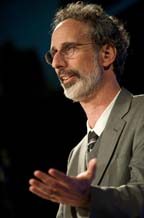Dialogues on the Environment: Q&A with Peter Gleick
 Peter Gleick knows water.
Peter Gleick knows water.
An environmental scientist and communicator and co-founder of the Pacific Institute, the MacArthur “genius” fellow and member of the U.S. National Academy of the Sciences is an expert on the connections between water, energy, food and health; the impacts of climate change; and international conflicts over water resources.
In 2008, Wired Magazine named Dr. Gleick “one of 15 people the next President should listen to.” Let’s hope the President got his message.
I recently spoke with Dr. Gleick on the occasion of the new PBS series EARTH: A New Wild. Wednesday’s episode—the final in the series—explores people’s relationship with water in some of the planet’s most spectacular places.
Mark Tercek: You’re trying to change the way people think about water. What do you mean by that?
Peter Gleick: It is time to stop thinking about water as a resource simply to be consumed and to think about how critical it really is for human and ecological survival, growing the food needed by over 7 billion people, countless social and cultural customs, and the production of all the goods and services we consume. Currently we overuse it, pollute it and fight over it. We need to move toward a sustainable water future, where our water needs can be met while protecting and satisfying the needs of the environment and future generations.
Mark Tercek: You recently said, “We have 19th century water policy and 20th century infrastructure, trying to deal with a 21st century climate.” How can we close that gap?
Peter Gleick: Our water systems will have to adapt to the new realities of our world, challenges like climate change, a burgeoning population and new political and social conflicts. That means using new technology to produce and purify water, new economic tools to help pay for the investments needed and new institutions and policies that take into account a rapidly changing world.
Mark Tercek: Tell us about your concept of the “soft path” for water.
Peter Gleick: First you must understand the “hard path,” traditional strategies focused on building large, centralized engineered water systems managed by large, centralized institutions. That hard path brought great advantages to society, but also came with significant, often unrecognized costs to local communities and the environment. The “soft path” integrates smart use of technology to manage both water supply and demand, innovative economic strategies to help fund new investment and to encourage efficient use and new effective institutions that manage water for a sustainable future.
Mark Tercek: In EARTH A New Wild, we visit the Colorado River and the Aral Sea—two places that illustrate your idea of “peak water.” Is there any hope for restoring a water source that has reached that limit?
Peter Gleick: A growing number of rivers, lakes, and freshwater ecosystems are stressed and stretched to the breaking point – what I call “peak water” limits. The Colorado River and the Aral Sea are two dramatic examples. It is certainly possible to restore some flows for the natural ecosystems like the formerly verdant and ecologically rich Colorado River delta, and to try to restore the Aral Sea: in both cases by guaranteeing at least some minimum flows for ecological purposes.
But sometimes thresholds are reached or passed from which there can be no return. In the Aral Sea, the 24 or so species of fish that were endemic – found nowhere else on Earth – are now extinct. These can never be brought back and represent the worst consequence of unsustainable water management and use. We must strive to both prevent these kinds of irreversible impacts and to make sure that our water policies benefit both society and our natural world.
Mark Tercek: What gives you hope for our water future?
Peter Gleick: There is much more attention and awareness about our water challenges today than a few decades ago. As we learn more about the water problems around the world, we also are learning how much people care. Water is so precious and fundamental that individuals and communities are mobilizing to protect their waters, to have a say in decisions for the future and to push to move along a “soft path.” Every day I learn about new efforts to find solutions to our water problems, and I have no doubt that we will one day reach a sustainable water future. I only hope we do so quickly enough to be able to avoid the worst of the threats that we face.